|

by
David Anderson, Ph.D.
(Part 1 of 3)
from
SkyBooksUSA
Website
In this series of articles we will show a solution using a
rotating
cylinder model that demonstrates how time travel is possible within
the context of general relativity. This solution clearly permits
time travel and communication not only to the future, but also to
the past. Most important, it will show how reverse time travel can
be achieved without having to travel faster than the speed of light.
The advanced computer simulations we have run at the Time Travel
Research Center have confirmed this model as a valid approach for
actual time travel to the past.
Introduction
 The rotating cylinder model is based on a conclusion of general
relativity that shows rotation of matter causes a distortion in
space-time. This distortion can become powerful enough to actually
twist time around a rotating cylinder. The rotating cylinder model is based on a conclusion of general
relativity that shows rotation of matter causes a distortion in
space-time. This distortion can become powerful enough to actually
twist time around a rotating cylinder.
With the right amount of mass and speed, a pattern of what are
referred to as "closed time-like curves" can be created.
Navigating through this pattern of closed time-like curves will
permit time travel to both the future and the past without violating
the laws of mathematics and physics.
To understand time control using rotating cylinders requires some
understanding of general relativity. An overview of the "General
Theory of Relativity" has been included as a separate article in
this issue of The Space-Time Journal. It also requires a basic
understanding of space-time physics, including the ideas of
space-time diagrams, light-cones and closed time-like curves.
Following is a brief review of these topics.
Space-Time Diagrams
 A common tool we use to discuss space-time is the space-time
diagram. This diagram plots the position of a particle as it moves
through space-time. By connecting all the plotted positions, a line
called the "world line" of the particle is created. A common tool we use to discuss space-time is the space-time
diagram. This diagram plots the position of a particle as it moves
through space-time. By connecting all the plotted positions, a line
called the "world line" of the particle is created.
In reality, a true space-time diagram would have four dimensions
including three space dimensions and one time dimension. This type
of diagram is very difficult to illustrate and visualize. Wherever
possible we use a simpler convention to illustrate concepts in
space-time.
The illustration to the right shows a simplified space-time diagram
with just one space axis (y) representing motion through one space
dimension, and one time axis (t) representing motion through time.
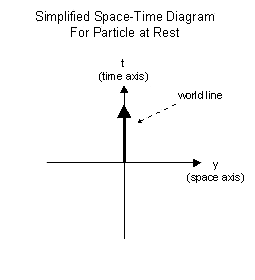 Lets look at the example of a particle starting at rest on the
origin of the y and t axes. If the particle does not move over time
in the space dimension (y) it will not move off the time axis (t). Lets look at the example of a particle starting at rest on the
origin of the y and t axes. If the particle does not move over time
in the space dimension (y) it will not move off the time axis (t).
So for a particle at rest in some observers’ frame of reference, its
space-time diagram for that observer is a vertical world line. This
is illustrated in the space-time diagram to the right showing a
particle at rest.
 The path the particle follows, whether it moves in the space
dimension (y), time dimension (t), or both represents what we call
its world line. The path the particle follows, whether it moves in the space
dimension (y), time dimension (t), or both represents what we call
its world line.
The world line represents the path the particle
follows in space-time as a whole.
If the particle moves in the space dimension (y), its world line
tilts away from the vertical as is illustrated in the space-time
diagram of a particle moving at constant speed shown to the left.
Straight (un-curved) world lines like this represent un-accelerated
particles (i.e.) particles experiencing no forces.
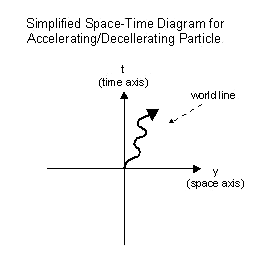 If a particle experiences acceleration, its world line will curve
away from the vertical time axis. If the same particle experiences
deceleration, its world line will curve back towards the vertical
time axis. If a particle experiences acceleration, its world line will curve
away from the vertical time axis. If the same particle experiences
deceleration, its world line will curve back towards the vertical
time axis.
The resulting world line will be curved as is illustrated in the
space-time diagram of an accelerating/decelerating particle on the
left.
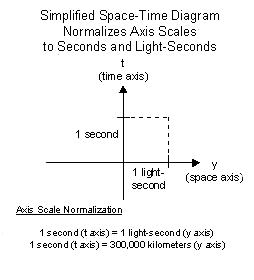 In order to make a space-diagram more meaningful in has become
common practice to normalize the axis to a specific standard. In order to make a space-diagram more meaningful in has become
common practice to normalize the axis to a specific standard.
Each unit on the time axis (t) is set to a second and each unit on
the space axis (y) is set to one light-second.
A light-second is the
distance that light can travel in one second, which is 300,000
kilometers.
This normalization of axes is illustrated to the left.
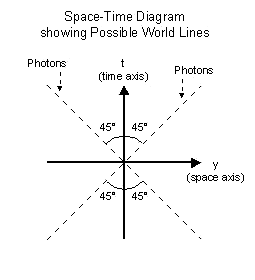 Since photons travel at the speed of light, this means that the
world line of a photon is tilted away from the vertical time axis by
and angle of 45 degrees, or 300,000 km/sec. Since photons travel at the speed of light, this means that the
world line of a photon is tilted away from the vertical time axis by
and angle of 45 degrees, or 300,000 km/sec.
If we accept a speed limit of the speed of light as is general
believed, the area between the world lines of the photons represents
the area where all possible world lines must be contained.
The
illustration to the left shows that the paths of all possible world
lines will never tilt more than 45 degrees away from the vertical.
Light Cones:
As we recall, a true space-time diagram would have the time
dimension plus three space dimensions. But again, this can be
extremely difficult to both draw and visualize. But by adding
another dimension, our 45º area around the time axis wraps around
the time axis and also upward and downward becoming a three
dimensional "light cone." This light cone with two space dimensions
is illustrated below.
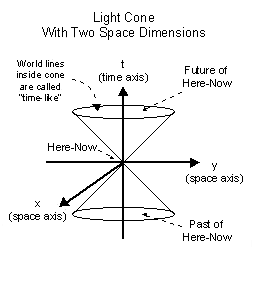 Lets call the point in space-time located at the origin of all three
axes (x=0, y=0, and t=0) the Here-Now. Then all points in the upward
region are located in the future of Here-Now. Also, all points in
the downward region are located in the past of Here-Now. Lets call the point in space-time located at the origin of all three
axes (x=0, y=0, and t=0) the Here-Now. Then all points in the upward
region are located in the future of Here-Now. Also, all points in
the downward region are located in the past of Here-Now.
From Here-Now a particle can travel to any other point in the future
light cone by traveling at a speed less than the speed of light.
Also, any particle inside the past light cone can travel to Here-Now
by traveling at less than the speed of light.
In this diagram the present is represented by the point where the
two cones meet in the middle (i.e. here-now). Since we generally
assume that we are restricted to at most the speed of light, the
cone above here-now represents the only possible "future" states of
the event, while the bottom cone represents restrictions on possible
pasts of here-now.
Space-Time Intervals
The distance between any two space-time points on a world line on
this space-time diagram is defined as:

The future cone represents those areas where "ds" is positive and
"t" is also positive. The past cone includes space-time points with
"ds" positive and with "t" negative.
Those volumes outside the two cones represent what is sometimes
called "Elsewhere," since they are events for which the metric "ds"
is imaginary. For one event to influence another event, it is
necessary that the event that is to provide the influence lie in the
past cone of the event being influenced.
We typically refer to three different types of space-time intervals.
These are commonly called time-like, space-like and light-like.
On our space-time diagrams a time-like displacement is one with an
angle to the time axis of less than 45°. A time-like displacement
represents an object traveling at a speed of less than the speed of
light. Time-like intervals have positive ds values.
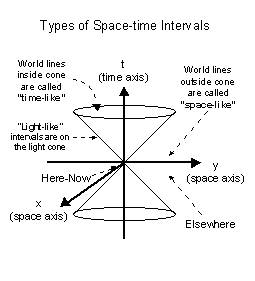 A light-like interval is one that makes an angle of 45° to the time
axis. Light of course travels on light-like intervals. A light-like interval is one that makes an angle of 45° to the time
axis. Light of course travels on light-like intervals.
The third possibility is a space-like interval, which represents a
line that makes an angle of more than 45° to the time axis.
Space-like intervals have negative ds values. Events joined by a
space-like interval can never influence each other, since that would
imply a flow of information at speeds faster than the speed of
light.
Its very important to note that every point in space-time has its
own, and potentially differently-oriented light cone.
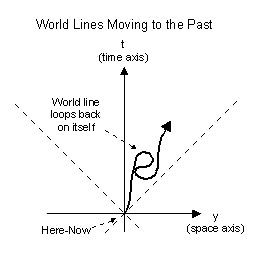 Space-time diagrams can also be used to represent world lines that
travel into the past instead of the future. As shown in the
illustration to the right a world line can loop back on itself. In
this example the world line curves back and comes close to itself. Space-time diagrams can also be used to represent world lines that
travel into the past instead of the future. As shown in the
illustration to the right a world line can loop back on itself. In
this example the world line curves back and comes close to itself.
On a world line it is important to remember that the direction of
the world line is in the direction of the local future of the
particle. Events happen in a sequence and direction of the world
line. If the particle is a living person then memories would also be
formed in the direction of the world line.
A subtle implication of this "loop back" is that it is only possible
by both moving through space and also exceeding the speed of light.
As soon as the loop bends more than 45 degrees away from the time
axis the particle must be traveling at a faster than light speed.
Closed Time-like Curves
So how can reverse time travel be possible at sub-light speed? By
understanding and using curved space-time. There are two important
points here that we will use later to show how reverse time travel
is indeed possible at sub-light speed.
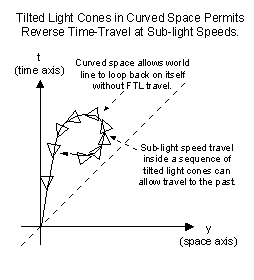 First, general relativity shows that space-time can be curved by
heavy gravity. Second, every point in space-time has its own light
cone. In a curved space-time it is possible to "tilt" or "tip over"
light cones. With a sufficient amount of space-time curvature a
particle or person could continue to move into their own local
future at sub-light speed but actually travel along a world line
that loops back on itself as shown in the illustration. First, general relativity shows that space-time can be curved by
heavy gravity. Second, every point in space-time has its own light
cone. In a curved space-time it is possible to "tilt" or "tip over"
light cones. With a sufficient amount of space-time curvature a
particle or person could continue to move into their own local
future at sub-light speed but actually travel along a world line
that loops back on itself as shown in the illustration.
This loop
back is commonly referred to as a closed time-like curve, a concept
introduced by Kurt Godel in 1949.
This world line could carry the particle or person backwards into
time without violating the laws of mathematics and physics… and
without having to travel faster than light!
Lets now take detailed look at a rotating cylinder model that could
create a curved space-time like this, permitting time travel to the
future, the past, and back again.
The Rotating Cylinder
In 1974 Frank Tipler published what appeared to be the construction
details for a time machine. His paper even concluded with the quote,
"In short, general relativity suggests that if we construct a
sufficiently large rotating cylinder, we create a time machine."
Tipler was continuing to build upon the study of rotating cylinders
and the relation of general relativity that actually been around for
decades. References can even be found for literature on rotating
infinite cylinders dating back to 1932.
However, Tipler was the first to publish his work in a respectable
scientific journal and show a solution free of singularities and
other problems associated with black hole models. Tipler was also
the only scientist at the time to show a solution that violated
causality.
What does this rotating cylinder look like? Let’s take a look.
The one result from general relativity that we will be using is that
the rotation of matter causes a distortion in space-time that
results in the tipping over of light cones. The rotating, infinite
cylinder is a method that can be used to artificially produce the
tipped-over light cone effect creating closed time-like curves.
The best way to picture a rotating cylinder would be to take a piece
of material ten times the mass of the Sun and compress it into a
long, thin, super-dense cylinder. Then spin the cylinder up to a few
billion revolutions per minute. The cylinder must rotate with a
surface speed of at least half the speed of light. This is necessary
to create centrifugal forces that will balance the gravitational
attraction of the super-dense material used to construct the
cylinder to prevent collapse or explosion.
By moving around the surface in a carefully plotted spiral course
one could travel through time into the past. One could also make the
return trip back to the original time of departure. The integrity of
this model holds on paper and it does not violate the laws of
mathematics and physics.
How does it work
General relativity shows how rapid rotation can actually twist
space-time creating and allowing movement through closed time-like
curves into the past. This is again accomplished at sub-light speed
travelling through a series of tipped light cones in curved space.
One method to artificially produce closed time-like curves is to use
a rotating, super-dense cylinder.
We will use the diagram titled "Closed Time-like Curve Formation
using a Rotating Cylinder Model" to illustrate how this works.
The rotating cylinder will spin along the vertical time axis shown
in the illustration.
The gravitational effects on space-time
curvature are weaker distant from the cylinder but grow stronger the
nearer one approaches the cylinder.

At a distance from the cylinder the resulting curvature of
space-time is small and the light cones are upright pointing almost
directly in the positive time (+t) direction. This is the typical
orientation for any point a normal or flat space-time.
The closer one approaches the rotating cylinder the stronger the
space-time curvature which can be illustrated by the tipped over
light cones. The effect of the rotating cylinder is to curve
space-time, which can be illustrated by the light cones that tip
further in the direction of rotation as we come closer to the
cylinder.
The light cones closest to the cylinder are tipped more than 45
degrees. This is far enough that part of the inside of their cone
actually is tipped through the x,y plane and into the negative time
(-t) direction.
With part of our future light cone now tipped into
the past we now are in a region where the roles of space and time
interchange and time itself is twisted around the cylinder.
Backwards in Time at Sub-light Speeds
To travel back in time the time traveler would approach the cylinder
and carefully navigate into a region of high space-time curvature.
Following a helical path around the cylinder the time traveler would
spiral down into the negative time (-t) direction. Notice that the
time traveler's motion only needs to be a sub-light speed and stays
completely within the local future of his light cone.
By navigating a course that always moving into his local future the
time traveller can follow a path at sub-light speeds that will carry
him backwards into time where he can steer away from the cylinder
and then exit in his own distant past.
Time travel to the future, time travel to the past… even travel to
the past and return to the future. This is all possible within the
laws of mathematics and physics.
Within general relativity are
secrets that will allow us to unlock the possibilities of
interstellar travel and time travel.
-
Explore how to navigate the Cylinder for forward and reverse time
travel
-
Examine some detailed mathematical models of the rotating cylinder
Model
-
Study some other interesting
implications and uses of the rotating cylinder
|

 The rotating cylinder model is based on a conclusion of general
relativity that shows rotation of matter causes a distortion in
space-time. This distortion can become powerful enough to actually
twist time around a rotating cylinder.
The rotating cylinder model is based on a conclusion of general
relativity that shows rotation of matter causes a distortion in
space-time. This distortion can become powerful enough to actually
twist time around a rotating cylinder. A common tool we use to discuss space-time is the space-time
diagram. This diagram plots the position of a particle as it moves
through space-time. By connecting all the plotted positions, a line
called the "world line" of the particle is created.
A common tool we use to discuss space-time is the space-time
diagram. This diagram plots the position of a particle as it moves
through space-time. By connecting all the plotted positions, a line
called the "world line" of the particle is created. Lets look at the example of a particle starting at rest on the
origin of the y and t axes. If the particle does not move over time
in the space dimension (y) it will not move off the time axis (t).
Lets look at the example of a particle starting at rest on the
origin of the y and t axes. If the particle does not move over time
in the space dimension (y) it will not move off the time axis (t). The path the particle follows, whether it moves in the space
dimension (y), time dimension (t), or both represents what we call
its world line.
The path the particle follows, whether it moves in the space
dimension (y), time dimension (t), or both represents what we call
its world line.
 If a particle experiences acceleration, its world line will curve
away from the vertical time axis. If the same particle experiences
deceleration, its world line will curve back towards the vertical
time axis.
If a particle experiences acceleration, its world line will curve
away from the vertical time axis. If the same particle experiences
deceleration, its world line will curve back towards the vertical
time axis. In order to make a space-diagram more meaningful in has become
common practice to normalize the axis to a specific standard.
In order to make a space-diagram more meaningful in has become
common practice to normalize the axis to a specific standard. Since photons travel at the speed of light, this means that the
world line of a photon is tilted away from the vertical time axis by
and angle of 45 degrees, or 300,000 km/sec.
Since photons travel at the speed of light, this means that the
world line of a photon is tilted away from the vertical time axis by
and angle of 45 degrees, or 300,000 km/sec. Lets call the point in space-time located at the origin of all three
axes (x=0, y=0, and t=0) the Here-Now. Then all points in the upward
region are located in the future of Here-Now. Also, all points in
the downward region are located in the past of Here-Now.
Lets call the point in space-time located at the origin of all three
axes (x=0, y=0, and t=0) the Here-Now. Then all points in the upward
region are located in the future of Here-Now. Also, all points in
the downward region are located in the past of Here-Now. A light-like interval is one that makes an angle of 45° to the time
axis. Light of course travels on light-like intervals.
A light-like interval is one that makes an angle of 45° to the time
axis. Light of course travels on light-like intervals. Space-time diagrams can also be used to represent world lines that
travel into the past instead of the future. As shown in the
illustration to the right a world line can loop back on itself. In
this example the world line curves back and comes close to itself.
Space-time diagrams can also be used to represent world lines that
travel into the past instead of the future. As shown in the
illustration to the right a world line can loop back on itself. In
this example the world line curves back and comes close to itself.
 First, general relativity shows that space-time can be curved by
heavy gravity. Second, every point in space-time has its own light
cone. In a curved space-time it is possible to "tilt" or "tip over"
light cones. With a sufficient amount of space-time curvature a
particle or person could continue to move into their own local
future at sub-light speed but actually travel along a world line
that loops back on itself as shown in the illustration.
First, general relativity shows that space-time can be curved by
heavy gravity. Second, every point in space-time has its own light
cone. In a curved space-time it is possible to "tilt" or "tip over"
light cones. With a sufficient amount of space-time curvature a
particle or person could continue to move into their own local
future at sub-light speed but actually travel along a world line
that loops back on itself as shown in the illustration.
